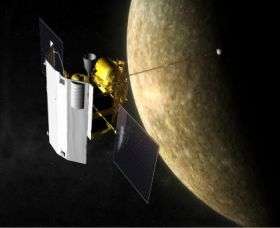Artist's concept of the NASA's MESSENGER spaceraft at Mercury. Credit: NASA
Today, the MESSENGER team celebrates the third anniversary of the probe's Mercury orbit insertion. On March 17, 2011 (Eastern Daylight Time), the spacecraft made history when it became the first probe to orbit the innermost planet. Over the last three years, MESSENGER instruments have fully mapped Mercury's surface and yielded discoveries that have changed views on how the inner planets formed and evolved.
The latest findings will be described in 25 papers presented this week at the 45th Lunar and Planetary Science Conference in The Woodlands, Texas. Now—as a key part of MESSENGER's second extended mission—the team is preparing to embark on a low-altitude imaging campaign that promises to reveal even more information about Mercury.
The altitude of the spacecraft at closest approach has been slowly decreasing as the Sun's gravity perturbs its orbit around Mercury, and the progressively closer approaches will provide MESSENGER's instruments with an unprecedented opportunity to make high-resolution observations of the planet. For example, the hollows first revealed by the probe's instruments in 2011 are suspected to have formed because volatile elements sublime off the surface, but observations to date could not confirm this hypothesis.
At spacecraft altitudes below 350 kilometers, the Mercury Dual Imaging Instrument's Narrow Angle Camera will acquire images with pixel scales ranging from 20 meters to as little as 2 meters. Such high-resolution images will reveal small features of the enigmatic hollows for the first time. "We will be seeing features at up to 10 times the resolution of the images acquired so far," noted MESSENGER Co-Investigator Scott Murchie of the Johns Hopkins University Applied Physics Laboratory (APL).
"Our spacecraft team is delighted to celebrate the third anniversary of MESSENGER's orbit insertion at Mercury," adds MESSENGER Principal Investigator Sean Solomon, of Columbia University's Lamont-Doherty Earth Observatory. "However, some of the most exciting observations from the mission are still to come. We can expect new surprises as we view the innermost planet from closer range than ever before achieved by spacecraft."
The lowest point of MESSENGER's orbit is now 226 kilometers (140.4 miles) above Mercury's surface. This minimum altitude will continue to decrease until the first maneuver of the mission's low-altitude campaign in mid-June 2014. Following the maneuver, the spacecraft's altitude at closest approach will continue to decrease until raised by additional maneuvers in September 2014, October 2014, and January 2015. At that point, MESSENGER will have spent its onboard fuel, and additional maneuvers to raise the minimum altitude will not be possible. In March 2015, the spacecraft will impact the surface of Mercury, having successfully completed four years in orbit about Mercury.
Provided by NASA
























